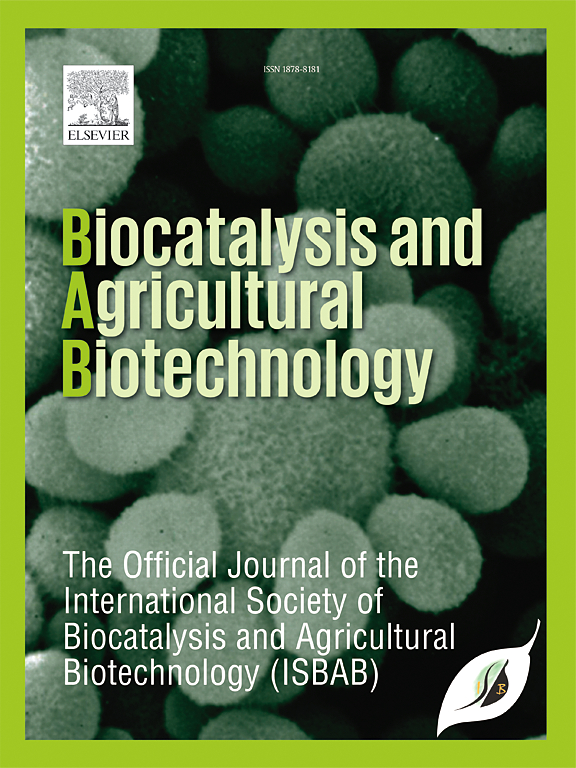Optimizing camelina performance under drought conditions through the combined action of nanochitosan-encapsulated rosemary oil and arbuscular mycorrhizal fungi
IF 3.8
Q2 BIOTECHNOLOGY & APPLIED MICROBIOLOGY
引用次数: 0
Abstract
Camelina is recognized for its high oil content and richness in α-linolenic acid, a key precursor for omega-3 fatty acid biosynthesis; however, it is increasingly affected by drought stress associated with climate change. This study evaluated the effects of rosemary essential oil encapsulated in nanochitosan (NPs), applied individually or combined with arbuscular mycorrhizal fungi (AMF), on growth, physiological traits, antioxidant defense, and oil yield and composition of camelina under different irrigation regimes. A two-year field experiment was conducted using a split-plot design based on a randomized complete block with three replications. The main plots included full irrigation throughout the growing season (IR1), limited irrigation from flowering (IR2), and limited irrigation from pod formation (IR3). Subplots comprised no treatment, foliar application of NPs, AMF inoculation, and the combined use of NPs and AMF. Drought stress, particularly when initiated from flowering, markedly impaired photosynthetic pigments, nutrient assimilation, relative water content, seed yield, oil-related traits, and the extent of mycorrhizal colonization. In contrast, the combined application of NPs and AMF, compared to no treatment and individual applications, significantly improved seed and oil yield alongside enhanced chlorophyll fluorescence, nutrient availability, accumulation of antioxidant metabolites including phenolics, flavonoids, ascorbic acid, proline, soluble sugars, and tocopherols. It also increased mycorrhizal colonization, stimulated enzymatic antioxidant defenses, and reduced oxidative stress markers such as malondialdehyde and hydrogen peroxide. Additionally, the oil profile improved through an increased proportion of unsaturated fatty acids accompanied by a decrease in saturated fatty acids. Overall, the results suggest that the co-application of nanochitosan-encapsulated rosemary essential oil and AMF may offer a sustainable and potentially effective strategy to enhance drought tolerance and improve seed and oil quality in camelina under water-limited conditions.
通过纳米壳聚糖包封迷迭香油和丛枝菌根真菌的联合作用,优化干旱条件下亚麻荠生长性能
亚麻荠富含α-亚麻酸,α-亚麻酸是生物合成omega-3脂肪酸的关键前体。然而,它越来越受到与气候变化有关的干旱胁迫的影响。研究了不同灌溉方式下,纳米壳聚糖(NPs)包封迷迭香精油单独施用或与丛枝菌根真菌(AMF)联合施用对茶树生长、生理特性、抗氧化防御、产油和组成的影响。采用3个重复的随机完全区,采用裂区设计进行了为期两年的田间试验。主要样地包括整个生长季全灌(IR1)、开花期限灌(IR2)和结荚期限灌(IR3)。亚图包括不处理、叶面施用氮磷酰胺、接种AMF和氮磷酰胺与AMF联合施用。干旱胁迫,特别是从开花开始的干旱胁迫,显著损害了光合色素、养分同化、相对含水量、种子产量、与油有关的性状和菌根定植的程度。相比之下,与不处理和单独施用相比,NPs和AMF联合施用显著提高了种子和油脂产量,同时增强了叶绿素荧光、养分利用率、抗氧化代谢物(包括酚类物质、类黄酮、抗坏血酸、脯氨酸、可溶性糖和生育酚)的积累。它还增加菌根定植,刺激酶抗氧化防御,减少氧化应激标志物,如丙二醛和过氧化氢。此外,通过增加不饱和脂肪酸的比例,同时减少饱和脂肪酸,油的剖面得到改善。综上所述,在水分限制条件下,纳米壳聚糖包封迷迭香精油和AMF的联合施用可能是一种可持续的、潜在的有效策略,可以提高亚麻荠的耐旱性,改善其种子和油质。
本文章由计算机程序翻译,如有差异,请以英文原文为准。
求助全文
约1分钟内获得全文
求助全文
来源期刊

Biocatalysis and agricultural biotechnology
Agricultural and Biological Sciences-Agronomy and Crop Science
CiteScore
7.70
自引率
2.50%
发文量
308
审稿时长
48 days
期刊介绍:
Biocatalysis and Agricultural Biotechnology is the official journal of the International Society of Biocatalysis and Agricultural Biotechnology (ISBAB). The journal publishes high quality articles especially in the science and technology of biocatalysis, bioprocesses, agricultural biotechnology, biomedical biotechnology, and, if appropriate, from other related areas of biotechnology. The journal will publish peer-reviewed basic and applied research papers, authoritative reviews, and feature articles. The scope of the journal encompasses the research, industrial, and commercial aspects of biotechnology, including the areas of: biocatalysis; bioprocesses; food and agriculture; genetic engineering; molecular biology; healthcare and pharmaceuticals; biofuels; genomics; nanotechnology; environment and biodiversity; and bioremediation.
 求助内容:
求助内容: 应助结果提醒方式:
应助结果提醒方式:


